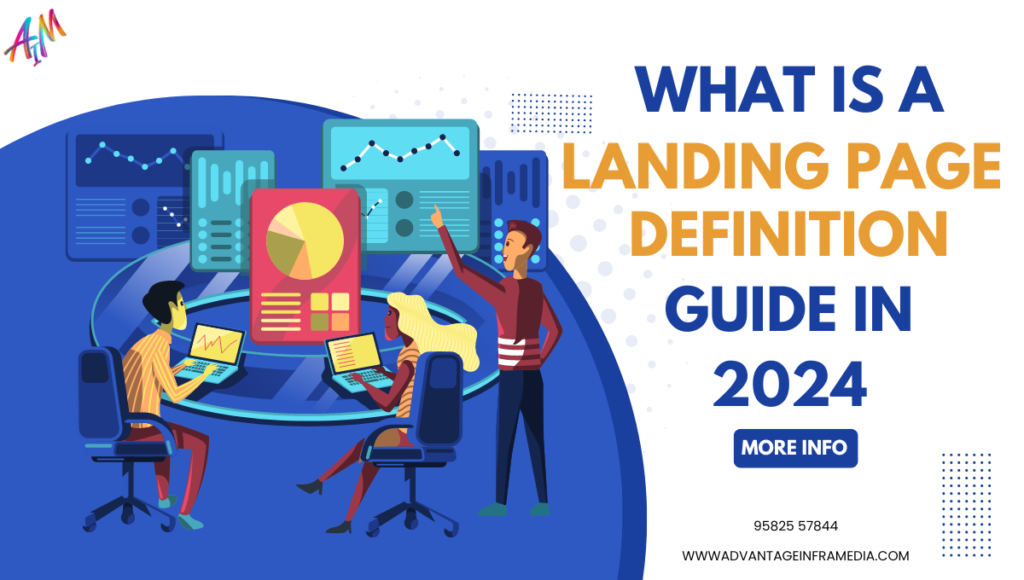What is a Landing Page?
In the digital marketing world, the term “landing page” is ubiquitous. But what exactly is a landing page, and why is it so crucial for online marketing success? This comprehensive guide will explore every aspect of landing pages, including their definition, types, importance, best practices, and design tips. By the end of this article, you’ll have a thorough understanding of how landing pages can enhance your digital marketing efforts and drive conversions.
Definition of a Landing Page
A landing page is a standalone web page designed specifically for a marketing or advertising campaign. It’s where a visitor “lands” after clicking on a link in an email, an ad from Google, Bing, YouTube, Facebook, Instagram, Twitter, or similar places on the web. Unlike other web pages, which typically have many goals and encourage exploration, landing pages are designed with a single focus or goal, known as a call to action (CTA).
The main purposes of a landing page are to capture leads, sell products, or encourage visitors to take a specific action. The effectiveness of a landing page is measured by its conversion rate, i.e., the percentage of visitors who complete the desired action.
Importance of Landing Pages
Higher Conversion Rates
Landing pages are tailored to a specific audience and designed to achieve a single goal, which makes them highly effective at converting visitors into leads or customers. By minimizing distractions and focusing on a clear call to action, landing pages can significantly boost conversion rates compared to a generic web page.
Targeted Messaging
Unlike homepages or other web pages, landing pages allow for highly targeted messaging. You can create different landing pages for different campaigns, keywords, or audience segments, ensuring that the message is relevant to the visitor. This relevancy increases the likelihood of conversion.
Enhanced Tracking and Analytics
Landing pages make it easier to track and measure the success of your marketing campaigns. By using unique URLs and tracking codes, you can analyze the performance of each landing page, identify what works and what doesn’t, and make data-driven decisions to optimize your campaigns.
Improved SEO and PPC Campaigns
Landing pages can be optimized for specific keywords and search queries, improving your search engine rankings and the quality score of your pay-per-click (PPC) campaigns. This optimization can lead to lower costs per click and higher ad placements, making your marketing efforts more cost-effective.
Lead Generation and Nurturing
Landing pages are a crucial tool for lead generation. By offering valuable content, such as eBooks, whitepapers, webinars, or free trials, in exchange for contact information, you can build a database of potential customers. These leads can then be nurtured through targeted email campaigns, gradually moving them down the sales funnel.
Types of Landing Pages
There are several types of landing pages, each designed to achieve a specific goal. The most common types include:
Lead Generation Landing Pages
Lead generation landing pages, also known as lead capture pages, are designed to collect contact information from visitors, typically in exchange for something of value, such as a free eBook, a discount, or access to a webinar. These pages usually feature a form where visitors can submit their details.
Click-Through Landing Pages
Click-through landing pages aim to warm up visitors and encourage them to click through to another page, usually a sales page or a checkout page. These pages often provide detailed information about a product or service, highlighting its benefits and features to convince visitors to take the next step.
Sales Landing Pages
Sales landing pages are designed to persuade visitors to make a purchase. These pages often include compelling product descriptions, high-quality images or videos, customer testimonials, and clear calls to action. The goal is to eliminate any objections and make the buying process as smooth as possible.
Squeeze Pages
Squeeze pages are a type of lead generation page that focuses on capturing email addresses. These pages typically offer a simple and concise form, with minimal distractions, to maximize the number of email sign-ups.
Thank You Pages
Thank you pages are the pages visitors see after completing a desired action, such as filling out a form or making a purchase. These pages confirm the successful completion of the action and often provide additional information or resources. They can also include upsell offers or encourage social sharing.
Best Practices for Landing Pages
Creating an effective landing page requires careful planning and attention to detail. Here are some best practices to follow:
Keep It Simple
A landing page should be focused and straightforward. Remove any unnecessary elements that could distract visitors from the main goal. The design should be clean, and the content should be concise.
Have a Clear and Compelling Headline
The headline is the first thing visitors see, so it needs to grab their attention and convey the main benefit of your offer. Make sure it’s clear, compelling, and aligned with the ad or link that brought them to the page.
Use Engaging Visuals
High-quality images, videos, and graphics can make your landing page more engaging and help convey your message more effectively. Ensure that visuals are relevant to your offer and complement the overall design.
Include a Strong Call to Action (CTA)
The CTA is the most crucial element of your landing page. It should be clear, concise, and action-oriented. Use contrasting colors to make it stand out, and place it prominently on the page. Test different CTAs to see which ones perform best.
Build Trust with Social Proof
Including testimonials, reviews, case studies, or logos of well-known clients can help build trust and credibility. Social proof reassures visitors that others have benefited from your offer, making them more likely to convert.
Optimize for Mobile
With a significant portion of web traffic coming from mobile devices, it’s essential to ensure your landing page is mobile-friendly. Use a responsive design that adjusts to different screen sizes and provides a seamless experience on all devices.
Test and Optimize
A/B testing (split testing) is crucial for optimizing your landing pages. Test different headlines, images, CTAs, and other elements to see which variations perform best. Use analytics to track performance and make data-driven decisions to improve conversion rates.
Design Tips for Effective Landing Pages
Design plays a critical role in the success of a landing page. Here are some design tips to help you create visually appealing and high-converting landing pages:
Use a Clear and Consistent Layout
A well-structured layout helps visitors navigate the page and find the information they need quickly. Use a consistent layout that aligns with your brand’s style and makes the content easy to read.
Leverage White Space
White space, or negative space, is the empty space around elements on your page. It helps to avoid clutter and makes the page more visually appealing. Use white space strategically to highlight important elements and guide visitors’ attention.
Choose the Right Colors
Colors can evoke emotions and influence behavior. Choose colors that align with your brand and the message you want to convey. Use contrasting colors for your CTA to make it stand out and attract attention.
Use Readable Fonts
Choose fonts that are easy to read and align with your brand’s style. Avoid using too many different fonts, as this can make the page look cluttered. Ensure that the text is large enough to be readable on all devices.
Incorporate Visual Hierarchy
Visual hierarchy helps guide visitors’ attention to the most important elements on the page. Use different font sizes, colors, and spacing to create a clear visual hierarchy. Important elements, such as the headline and CTA, should be more prominent.
Ensure Fast Loading Times
Page load speed is critical for user experience and SEO. Ensure that your landing page loads quickly by optimizing images, minimizing the use of heavy scripts, and using a reliable hosting service. A fast-loading page reduces bounce rates and improves conversion rates.
Examples of Successful Landing Pages
Analyzing successful landing pages can provide valuable insights and inspiration. Here are a few examples of effective landing pages:
Airbnb
Airbnb’s landing page for hosts is a great example of simplicity and clarity. The headline clearly communicates the main benefit (“Earn money as an Airbnb host”), and the page features a prominent CTA button (“Get Started”). The use of high-quality images and concise copy makes the page visually appealing and easy to understand.
Dropbox
Dropbox’s landing page is another excellent example. The headline is clear and concise (“Get to all your files from anywhere, on any device”), and the page uses a clean design with plenty of white space. The CTA button (“Sign up for free”) stands out with a contrasting color, and the inclusion of a customer testimonial adds social proof.
Shopify
Shopify’s landing page for their free trial is highly effective. The headline highlights the main benefit (“Start your free trial”), and the page features a simple form to sign up. The use of engaging visuals, clear CTAs, and social proof (logos of well-known brands using Shopify) makes the page compelling and trustworthy.
Advanced Strategies for Landing Pages
While basic best practices are essential, implementing advanced strategies can further enhance the effectiveness of your landing pages.
Personalization
Personalizing your landing pages based on visitor data can significantly increase engagement and conversion rates. Personalization can be based on:
- Geographic location: Display location-specific offers or content.
- Behavioral data: Tailor the content based on the visitor’s previous interactions with your site.
- Demographics: Customize the message based on age, gender, job title, etc.
- Referral source: Adjust the landing page content to match the message of the ad or link that brought the visitor to your page.
Dynamic Content
Dynamic content involves changing parts of your landing page content in real-time based on the visitor’s characteristics or behavior. This can make your landing page more relevant to individual visitors. Examples include changing text, images, or CTAs to match the visitor’s interests.
Progressive Profiling
Instead of asking visitors to fill out long forms initially, progressive profiling allows you to collect information incrementally over multiple interactions. Each time a visitor fills out a form, you gather new information while remembering previously collected data. This approach reduces friction and improves user experience.
A/B Testing and Multivariate Testing
While A/B testing compares two versions of a landing page, multivariate testing evaluates multiple elements simultaneously. For example, you can test different headlines, images, and CTAs in various combinations to determine the most effective configuration. Continuous testing and optimization are crucial for maximizing conversion rates.
Heatmaps and User Session Recording
Heatmaps and user session recordings provide visual insights into how visitors interact with your landing page. Tools like Hotjar or Crazy Egg can show you where users click, scroll, and spend the most time, helping you identify areas for improvement.
Utilize Exit-Intent Popups
Exit-intent popups are triggered when a visitor is about to leave your page. These popups can offer additional value, such as a discount or a free resource, to encourage the visitor to stay or convert. While they should be used sparingly to avoid being intrusive, they can be effective in reducing bounce rates.
Case Studies of Successful Landing Pages
Examining real-world examples of successful landing pages can provide valuable insights and inspiration for your own designs. Here are a few case studies:
Unbounce
Challenge: Unbounce wanted to increase conversions for their eBook download landing pages.
Solution: They created a dedicated landing pages with a clear, compelling headline and a strong CTA. The page included a brief description of the eBook’s benefits and a simple form to capture lead information.
Results: The new landing pages saw a 41% increase in conversions compared to their previous version.
HubSpot
Challenge: HubSpot needed to improve the conversion rate of their free CRM tool landing pages.
Solution: They optimized the page by simplifying the design, making the CTA more prominent, and adding customer testimonials to build trust.
Results: The optimized landing pages achieved a 52% increase in sign-ups.
Lyft
Challenge: Lyft aimed to attract more drivers through their driver recruitment landing pages.
Solution: They used a minimalist design with a strong headline, clear CTA, and compelling visuals. The page highlighted the benefits of driving for Lyft, including earnings potential and flexibility.
Results: The landing pages significantly increased the number of driver sign-ups, contributing to Lyft’s rapid growth.
Common Mistakes to Avoid
Creating a high-converting landing involves more than just following best practices. It also requires avoiding common mistakes that can hinder performance.
Lack of Clarity
A confusing or unclear message can deter visitors from taking action. Ensure that your headline, copy, and CTA are straightforward and clearly communicate the value proposition.
Too Many Distractions
Including too many elements, such as multiple CTAs, links, or unnecessary information, can overwhelm visitors and reduce conversion rates. Focus on a single goal and minimize distractions.
Ignoring Mobile Optimization
With a significant amount of traffic coming from mobile devices, failing to optimize your landing for mobile can result in a poor user experience and lost conversions. Ensure your page is responsive and loads quickly on all devices.
Poor-Quality Visuals
Low-quality images or videos can negatively impact the perceived professionalism of your landing. Use high-quality visuals that are relevant and enhance the overall design.
Lengthy Forms
Asking for too much information upfront can discourage visitors from completing the form. Keep forms as short as possible, only requesting essential information. You can gather additional details through progressive profiling.
Ignoring Analytics
Failing to track and analyze the performance of your landing means missing out on valuable insights. Use analytics tools to monitor key metrics and identify areas for improvement.
Future Trends in Landing Page Design and Optimization
The digital marketing landscape is continually evolving, and staying ahead of trends can help you create more effective landing.
AI and Machine Learning
Artificial intelligence and machine learning are becoming increasingly important in landing optimization. These technologies can analyze vast amounts of data to identify patterns and predict which elements will perform best. AI can also be used to personalize content and automate A/B testing.
Interactive Content
Interactive content, such as quizzes, polls, and interactive infographics, can engage visitors and increase the time they spend on your landing. This type of content can also provide valuable data for personalization and lead nurturing.
Voice Search Optimization
With the rise of voice-activated devices, optimizing your landing for voice search is becoming more important. This involves using natural language and long-tail keywords that match how people speak rather than type.
Augmented Reality (AR) and Virtual Reality (VR)
AR and VR technologies offer new ways to engage visitors and provide immersive experiences. For example, an AR feature on a landing could allow visitors to see how a product would look in their home.
Video Content
Video continues to be a powerful tool for engaging visitors. Including explainer videos, product demos, or customer testimonials on your landing can help convey your message more effectively and increase conversions.
Enhanced Data Privacy
With growing concerns about data privacy, it’s crucial to be transparent about how you collect and use visitor data. Ensure that your landing comply with data protection regulations, such as GDPR, and clearly communicate your privacy policy to build trust with visitors.
Conclusion
Landing pages are a fundamental component of digital marketing, offering a targeted and effective way to convert visitors into leads or customers. By understanding the different types of landing, following best practices, leveraging advanced strategies, and staying informed about future trends, you can create high-converting landing that drive significant results for your business.
Remember that the key to successful landing lies in continuous testing and optimization. Use data and insights to refine your approach, experiment with different elements, and always strive to improve the user experience. With dedication and attention to detail, your landing can become powerful tools in your digital marketing arsenal.




